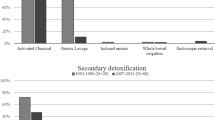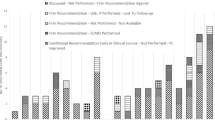Abstract
Intravenous fat emulsion (IFE) therapy is a novel treatment that has been used to reverse the acute toxicity of some xenobiotics with varied success. We sought to determine how US Poison Control Centers (PCCs) have incorporated IFE as a treatment strategy for poisoning. A closed-format multiple-choice survey instrument was developed, piloted, revised, and then sent electronically to every medical director of an accredited US PCC in March 2011. Addresses were obtained from the American Association of Poison Control Centers listserv, and participation was voluntary and remained anonymous. Data were analyzed using descriptive statistics. The majority of PCC medical directors completed the survey (45 out of 57; 79 %). Of the 45 respondents, all felt that IFE therapy played a role in the acute overdose setting. Most PCCs (30 out of 45; 67 %) have a protocol for IFE therapy. In a scenario with “cardiac arrest” due to a single xenobiotic, directors stated that their center would “always” or “often” recommend IFE after overdose of bupivacaine (43 out of 45; 96 %), verapamil (36 out of 45; 80 %), amitriptyline (31 out of 45; 69 %), or an unknown xenobiotic (12 out of 45; 27 %). In a scenario with “shock” due to a single xenobiotic, directors stated that their PCC would “always” or “often” recommend IFE after overdose of bupivacaine (40 out of 45; 89 %), verapamil (28 out of 45; 62 %), amitriptyline (25 out of 45; 56 %), or an unknown xenobiotic (8 out of 45; 18 %). IFE therapy is being recommended by US PCCs; protocols and dosing regimens are nearly uniform. Most directors feel that IFE is safe but are more likely to recommend IFE in patients with cardiac arrest than in patients with severe hemodynamic compromise.

Similar content being viewed by others
References
Weinberg G, VadeBoncouer T, Ramaraju G, Garcia-Amaro M, Cwik M (1998) Pretreatment or resuscitation with a lipid infusion shifts the dose-response to bupivacaine-induced asystole in rats. Anesthesiology 88:1071–1075
Rosenblatt M, Abel M, Fischer G, Itzkovich C, Eisenkraft J (2006) Successful use of a 20 % lipid emulsion to resuscitate a patient after a presumed bupivacaine-related cardiac arrest. Anesthesiology 105:217–218
Sirianni A, Osterhoudt K, Calello D, Muller A, Waterhouse M, Goodkin M, Weinberg G et al (2008) Use of lipid emulsion in the resuscitation of a patient with prolonged cardiovascular collapse after overdose of bupropion and lamotrigine. Ann Emerg Med 51(4):412–415, 415.e1
Young A, Velez L, Kleinschmidt K (2009) Intravenous fat emulsion therapy for intentional sustained-release verapamil overdose. Resuscitation 80(5):591–593
French D, Armenian P, Ruan W, Wong A, Drasner K, Olson K, Wu A (2011) Serum verapamil concentrations before and after Intralipid® therapy during treatment of an overdose. Clin Toxicol 49(4):340–344
Finn S, Uncles D, Willers J, Sable N (2009) Early treatment of a quetiapine and sertraline overdose with Intralipid. Anesthesia 64(2):191–194
Hillyard S, Barrera-Groba C, Tighe R (2010) Intralipid reverses coma associated with zopiclone and venlafaxine overdose. Eur J Anaesthesiol 27(6):582–583
Jovic-Stosic J, Gligic, Putic V, Brajkovic G, Spasic R (2011) Severe propranolol and ethanol overdose with wide complex tachycardia treated with intravenous lipid emulsion: a case report. Clin Toxicol 49(5):426–430
Montiel V, Gougnard T, Hantson P (2011) Diltiazem poisoning treated with hyperinsulinemic euglycemia therapy and intravenous lipid emulsion. Eur J Emerg Med 18(2):121–123
Cave G, Harvey M (2009) Intravenous lipid emulsion as antidote beyond local anesthetic toxicity: a systematic review. Acad Emerg Med 16(9):815–824
American College of Medical Toxicology (ACMT) National Office. Interim guidance for the use of lipid resuscitation therapy. Available at http://www.acmt.net/cgi/page.cgi/zine_service.html?aid=3384&zine=show. Accessed 4 March 2013
Bronstein A, Spyker D, Cantilena L, Rumack B, Dart R (2012) 2011 Annual report of the American Association of Poison Control Centers’ National Poison Data System (NPDS): 29th Annual Report. Clin Tox 50(10):911–1164
Darracq M, Thornton S, Do H, Bok D, Clark R, Cantrell F (2013) Utilization of hyperinsulinemia euglycemia and intravenous fat emulsion following Poison Center recommendations. J Med Toxicol. doi:10.1007/s13181-013-0290-2
Wax P, Kleinschmidt K, Brent J (2011) The Toxicology Investigators Consortium (ToxIC) Registry. J Med Tox 7(4):259–265
Geib A, Liebelt E, Manini F, Toxicology Investigator’s Consortium (ToxIC) (2012) Clinical experience with intravenous lipid emulsion for drug-induced cardiovascular collapse. J Med Tox 8(1):10–14
Acknowledgments
Thank you to all Poison Center participants in this study. We would also like to thank those who attended and participated at the 2011 North American Congress of Clinical Toxicology Fellow-In-Training Platform session where these data were initially presented.
Conflict of Interest
The authors report no conflict of interest. The authors alone are responsible for the content and writing of this paper.
Author information
Authors and Affiliations
Corresponding author
Electronic supplementary material
Below is the link to the electronic supplementary materials.
ESM 1
(PDF 216 kb)
Appendix
Appendix
Bar graph (Fig. 1) and the survey form.
Rights and permissions
About this article
Cite this article
Christian, M.R., Pallasch, E.M., Wahl, M. et al. Lipid Rescue 911: Are Poison Centers Recommending Intravenous Fat Emulsion Therapy for Severe Poisoning?. J. Med. Toxicol. 9, 231–234 (2013). https://doi.org/10.1007/s13181-013-0302-2
Published:
Issue Date:
DOI: https://doi.org/10.1007/s13181-013-0302-2




